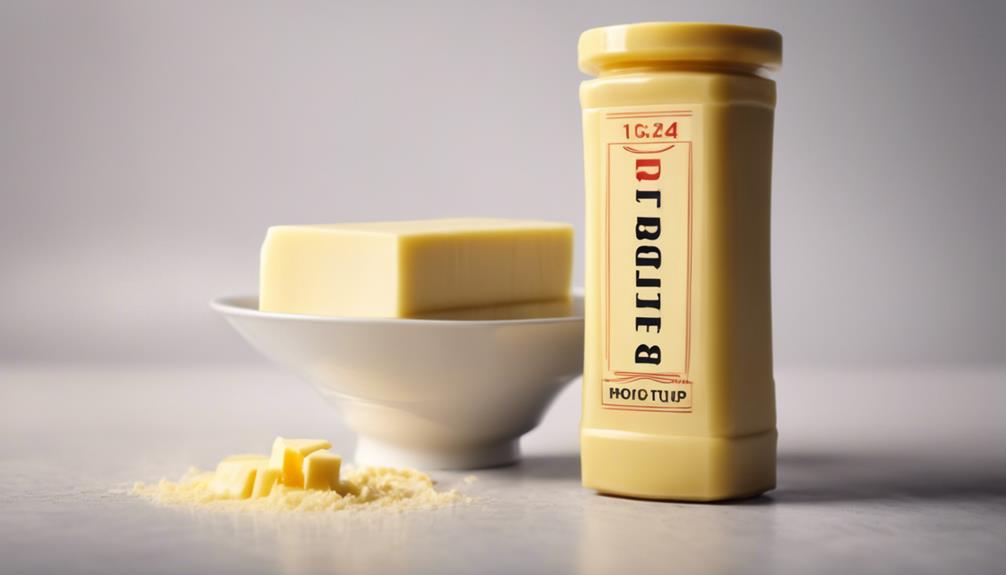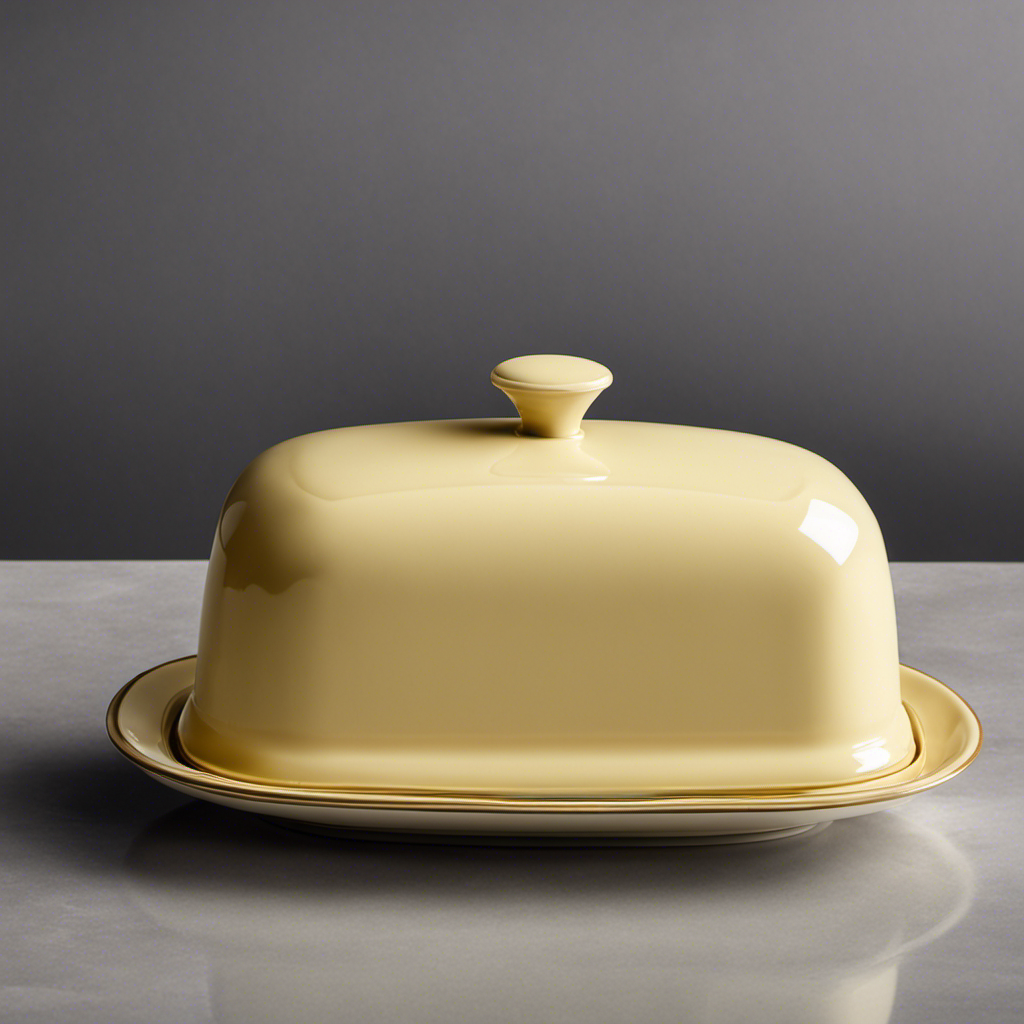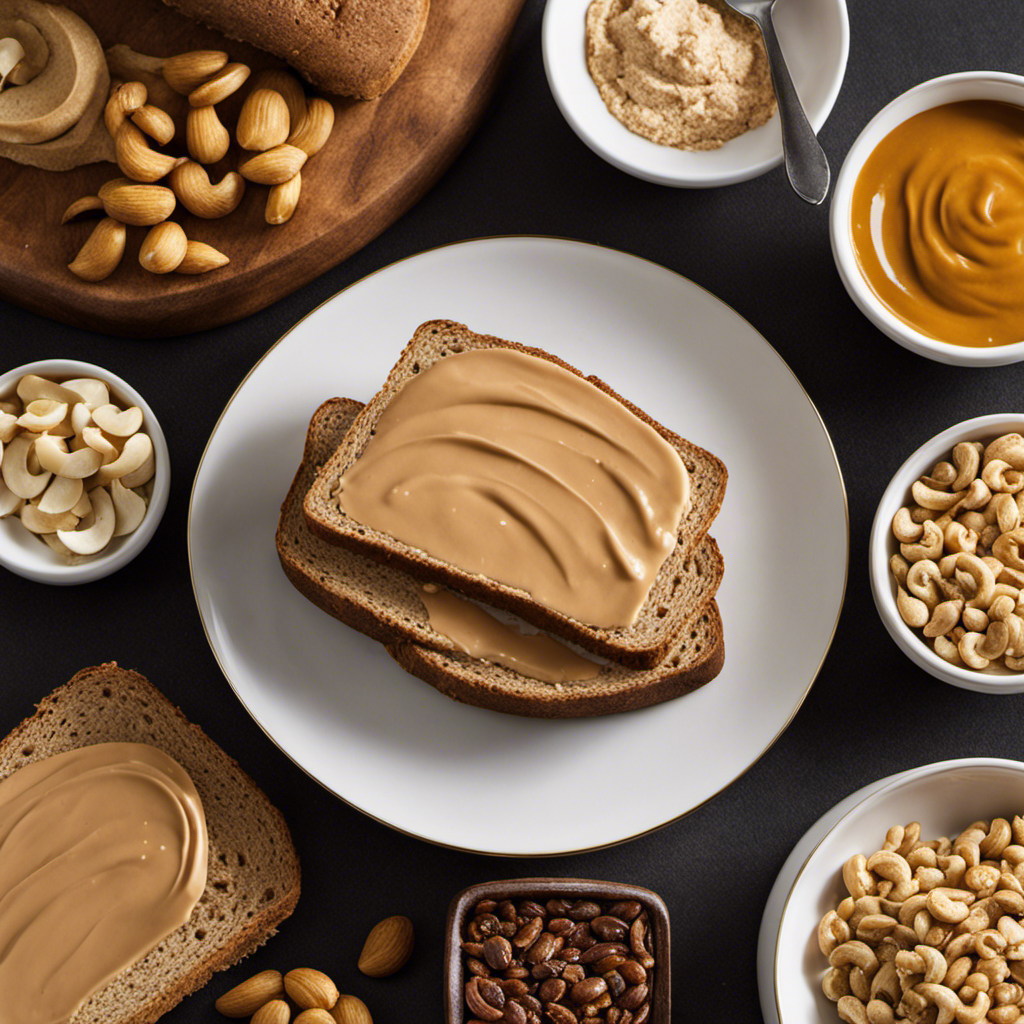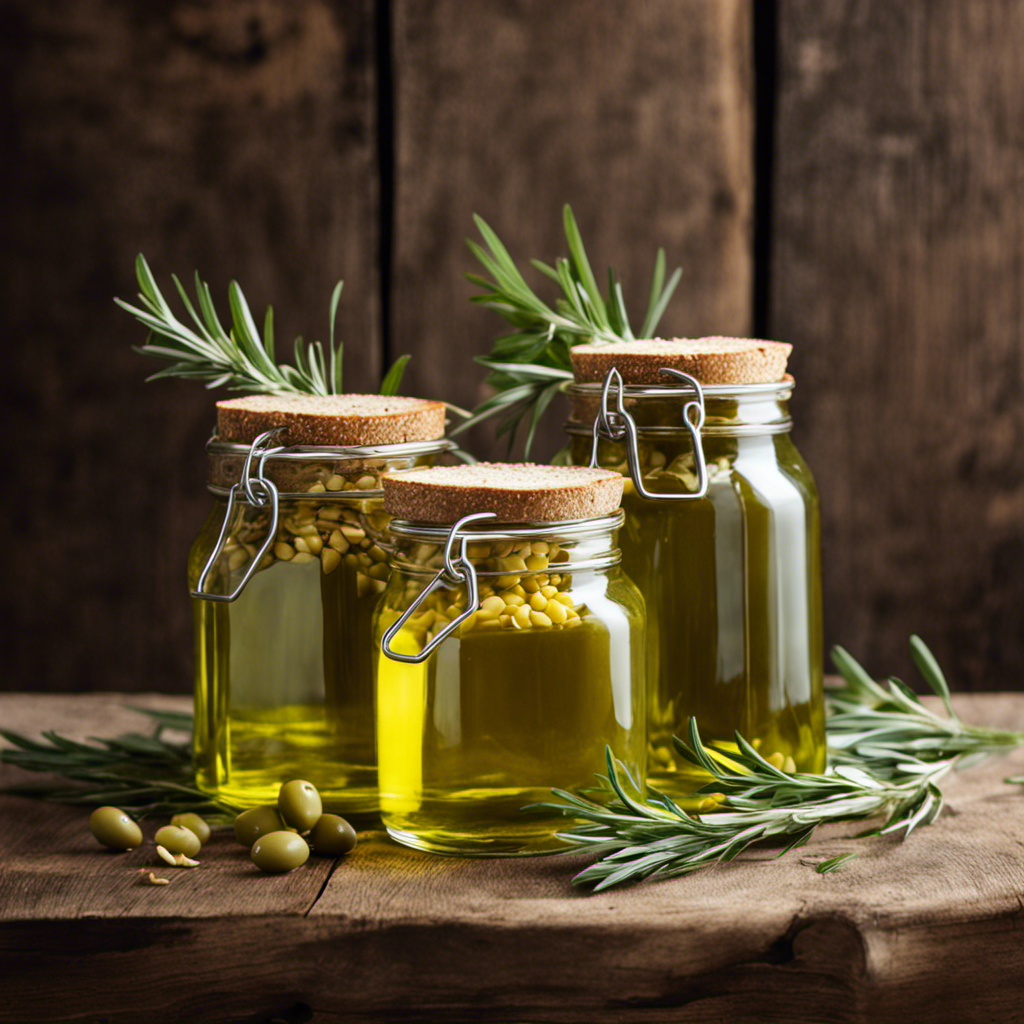To keep your pet safe, avoid peanut butter brands that contain xylitol, such as Go Nuts, Co., Krush Nutrition, Nuts N More, P28 Foods, and No Cow. Xylitol is extremely toxic to dogs and can cause severe health issues like hypoglycemia and liver damage. Always check ingredient labels before giving peanut butter to your pet. If your dog shows symptoms like vomiting, muscle weakness, or tremors, contact your vet immediately. Opt for natural peanut butter brands like Crazy Richard's, CB's Nuts, or Trader Joe's that don't contain xylitol. Learn about more safe choices and preventative measures ahead.
Key Takeaways
- Brands like Go Nuts, Co. and Krush Nutrition may contain xylitol, which is toxic to dogs.
- Nuts N More and P28 Foods have peanut butter products that might include xylitol.
- No Cow brand peanut butter could have xylitol, posing a risk to pets.
- Checking ingredient labels is critical to avoid xylitol in peanut butter.
- Avoiding brands with xylitol is necessary for pet safety.
Xylitol in Peanut Butter
When you're shopping for peanut butter, always check the label for xylitol to keep your dog safe. Xylitol is a sugar substitute that's toxic to dogs, even in small amounts. While it's fine for humans, it can cause severe health issues in dogs, including hypoglycemia, liver damage, and even death.
By being watchful about the ingredients in peanut butter brands, you can safeguard your furry friend from these dangers.
Not all peanut butter brands are safe for dogs. Some brands may use xylitol as a sweetener, making them potentially deadly for pets. To guarantee your dog's safety, you need to examine the ingredient list closely. If xylitol is listed, steer clear of that product.
It's a simple but essential step that can prevent serious complications for your pet.
Brands Containing Xylitol
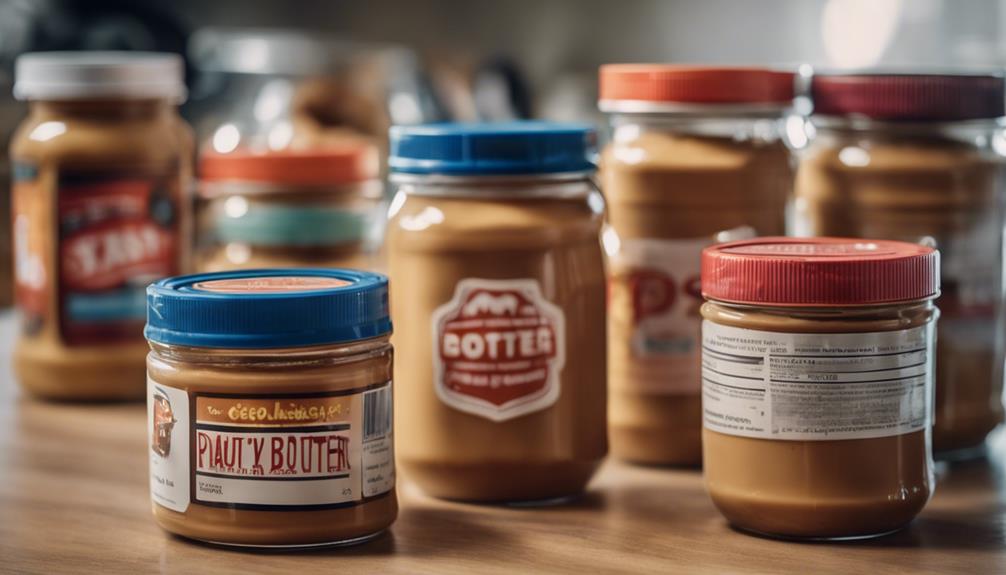
Some peanut butter brands, such as Go Nuts, Co., Krush Nutrition, Nuts N More, P28 Foods, and No Cow, contain xylitol, making them risky for your dog. When you're shopping for peanut butter, it's important to prioritize pet safety by carefully examining ingredient labels.
Xylitol is a sweetener that can be harmful to dogs, even in small amounts, leading to serious health issues.
To safeguard your furry friend, always double-check the ingredient labels on peanut butter jars. Many of these brands market their products as health-conscious options for humans, which can make them appealing. However, their inclusion of xylitol makes them a hidden danger for pets. If you're uncertain about a particular brand, do some quick research or contact the manufacturer directly to confirm whether their product contains xylitol.
Keeping your dog safe involves being watchful about what you bring into your home. By avoiding peanut butter brands that include xylitol, you can prevent potential emergencies and guarantee your pet's well-being.
Symptoms of Xylitol Poisoning
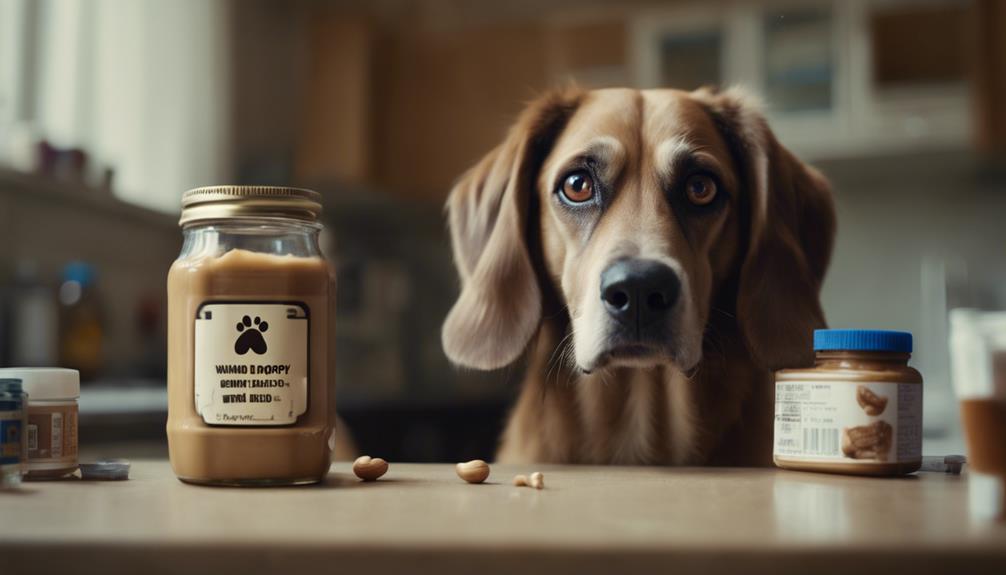
Spotting the symptoms of xylitol poisoning in your dog quickly can make a life-saving difference. Xylitol poisoning can manifest rapidly after ingestion, and knowing what to look for can help you take swift action.
Symptoms often start with vomiting, which is one of the first signs that something is wrong. As the condition progresses, your dog may show muscle weakness, tremors, and difficulty walking. These symptoms indicate a significant problem that requires immediate treatment.
Here are the key symptoms to watch for:
- Vomiting
- Muscle weakness
- Tremors
- Difficulty walking
Recognizing these symptoms early is vital because xylitol can cause severe health issues, including a dangerous drop in blood sugar and potential liver damage. Immediate treatment is essential to prevent these complications. If you notice any of these symptoms in your dog and suspect xylitol poisoning, it's essential to seek veterinary care immediately.
Veterinarians may need to monitor liver values and blood sugar, induce vomiting, and administer IV fluids with dextrose. Quick action and appropriate treatment can make all the difference in ensuring your dog's health and safety.
Immediate Actions to Take

If your dog consumes peanut butter containing xylitol, contact your veterinarian or a pet poison control hotline immediately to seek expert guidance. Quick action is vital because xylitol poisoning can be life-threatening. Induction of vomiting may be recommended as a first step to prevent further absorption of the toxin.
Here's a table of immediate actions to take:
| Immediate Action | Purpose | Notes |
|---|---|---|
| Contact Vet or Hotline | Expert guidance | Essential first step |
| Induce Vomiting | Prevent toxin absorption | Only if advised by a professional |
| Monitor Health | Track liver values and blood sugar levels | Continuous monitoring is essential |
After contacting the vet, they might instruct you to monitor your dog's liver values and blood sugar levels closely. This can involve regular blood tests to ensure that the xylitol hasn't caused severe damage. Intravenous fluids with dextrose might be necessary if your dog's blood sugar levels drop.
Knowing the brands that contain xylitol can help prevent future incidents. Remember, your dog's health is paramount, so acting promptly and following professional advice can make all the difference. Stay informed and always check ingredients to avoid xylitol and other harmful substances.
Safe Peanut Butter Options
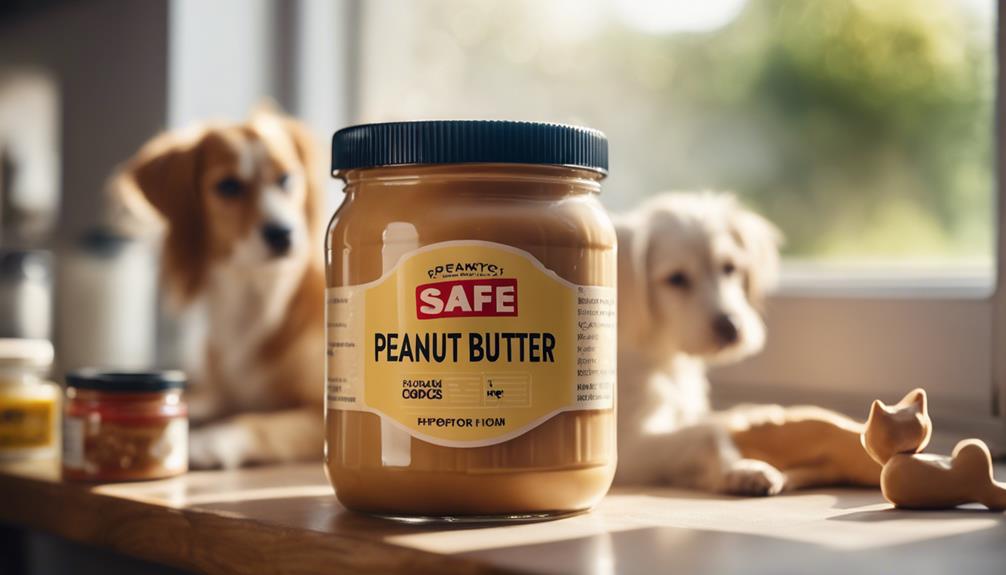
Wondering which peanut butter brands are safe for your dog? You're not alone. Many dog owners worry about harmful ingredients like xylitol, which can be toxic to dogs. Thankfully, there are plenty of xylitol-free peanut butter options that are both safe and healthy for your furry friend.
First, always choose natural peanut butter. Look for brands that contain just peanuts without added sugars or harmful oils. Some excellent choices include:
- Crazy Richard's: Known for its minimal ingredient list, ensuring that Peanut Butter is Secure for your dog.
- CB's Nuts: Offers xylitol-free peanut butter made from just peanuts, perfect for your pet's health.
- Homemade Peanut Butter: Made from roasted peanuts, this option allows you to control all ingredients, guaranteeing it's free from harmful additives.
- Trader Joe's Peanut Butter: Another great option with natural ingredients, but always double-check the label for safety.
Additionally, when choosing nut butters, avoid those made from toxic ingredients like bitter almonds. Keeping these tips in mind will help guarantee that your dog enjoys their peanut butter treat without any health risks.
Monitoring Your Dog's Health
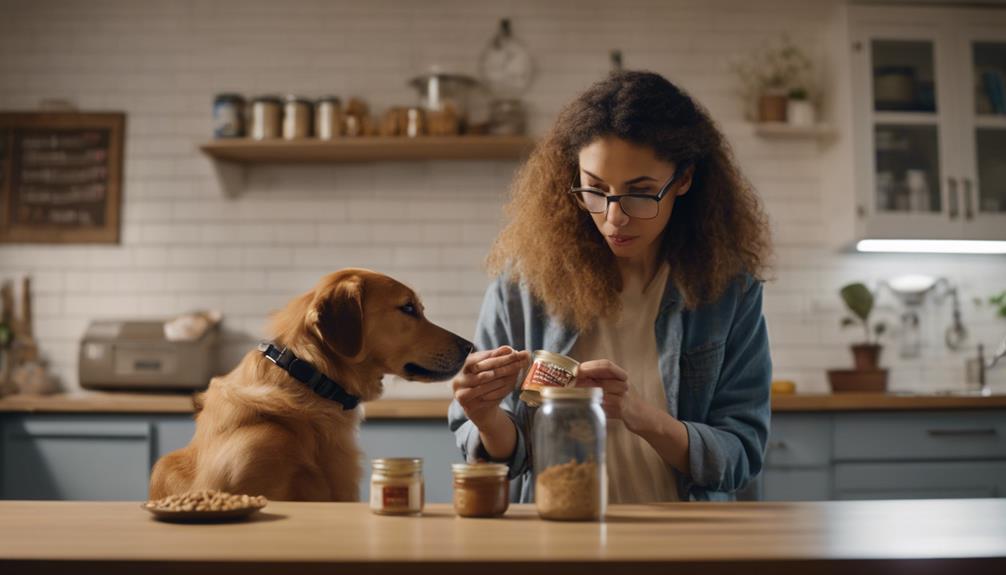
When monitoring your dog's health, it's important to watch for any signs of xylitol poisoning, such as vomiting or muscle weakness. Keep a close eye on your dog's behavior and alertness, especially if they've ingested peanut butter with xylitol.
Symptoms of xylitol poisoning can include tremors, lethargy, and even seizures. Act swiftly if you notice any of these symptoms. Contact your veterinarian immediately. They might run tests to check your dog's liver values and blood sugar levels. Both can be notably affected by xylitol poisoning. Low blood sugar levels can lead to hypoglycemia, which is dangerous and requires urgent care.
Regularly monitoring your dog's liver values is crucial. Xylitol can cause liver failure, which may not be immediately apparent but can develop over time. Your vet might suggest blood tests to keep track of any changes.
In some cases, your veterinarian may recommend IV fluids with dextrose to stabilize your dog's blood sugar levels. This treatment can help counteract the effects of xylitol and support your dog's recovery.
Preventing Xylitol Poisoning
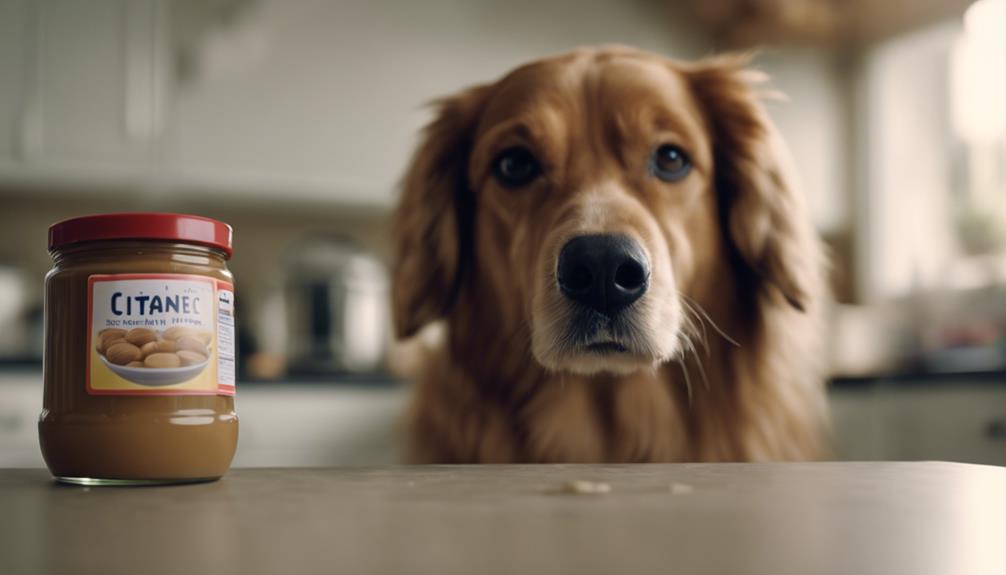
To prevent xylitol poisoning, always check the ingredient labels on peanut butter before giving it to your dog.
Educate yourself about xylitol-containing products to keep your pet safe.
Taking these simple steps can help you safeguard your dog's health.
Checking Ingredient Labels
Before offering peanut butter to your dog, make sure you check the ingredient label for xylitol. This artificial sweetener is toxic to dogs and can cause severe health issues if ingested. By carefully reading ingredient labels, you can prevent accidental xylitol poisoning and keep your furry friend safe.
When checking ingredient labels, keep the following tips in mind:
- Look for the word 'xylitol': This is the most straightforward way to identify if the peanut butter contains this harmful ingredient.
- Be wary of sugar-free products: Many sugar-free or 'diet' products use xylitol as a substitute.
- Research brands: Some brands are known to include xylitol in their products. A quick online search can help you identify these.
- Consult reliable sources: Veterinary websites and pet safety organizations often list peanut butter brands that contain xylitol.
Xylitol poisoning can occur rapidly, so it's essential to act fast if you suspect your dog has ingested contaminated peanut butter. Symptoms can include vomiting, loss of coordination, and seizures. Contact your veterinarian immediately for guidance and treatment if you notice any of these signs.
Educating Pet Owners
Educating pet owners about the dangers of xylitol in peanut butter is important for preventing accidental poisoning in dogs. You need to be aware that xylitol, a common sweetener, can be life-threatening to your furry friends. Always check the labels on peanut butter brands to make sure they don't contain this harmful ingredient.
Brands like Go Nuts, Co. and Nuts N More are known to include xylitol, so it's crucial to avoid them. If you notice any symptoms such as vomiting, loss of coordination, or seizures in your dog after eating peanut butter, contact your veterinarian immediately. The onset of symptoms can be rapid, and early intervention is key to your pet's survival.
It's not just about avoiding certain brands; it's about being vigilant every time you purchase peanut butter. Make it a habit to scrutinize ingredient lists, and educate other pet owners about the risks. By spreading awareness, you can help others prevent accidental poisoning in their dogs.
Companies' Response to Xylitol
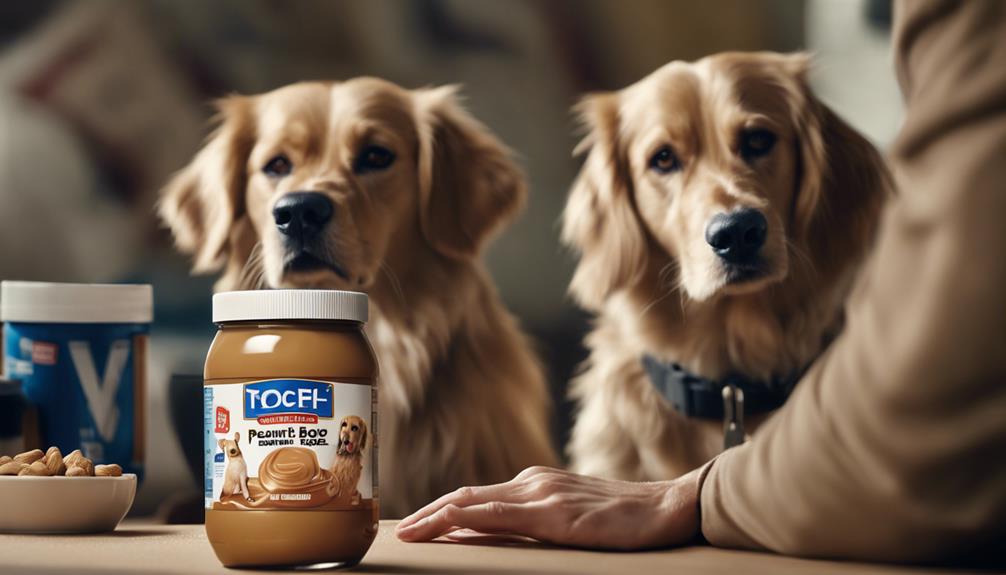
You'll notice that some companies are taking significant steps to address the risks of xylitol in peanut butter. Brands like No Cow and Hanks Protein Plus Nut Spreads have removed xylitol from their products, while Nuts N More has added warnings about its dangers to dogs.
These initiatives reflect a growing awareness and responsibility in the industry to protect pets.
Xylitol Removal Initiatives
In response to growing awareness of xylitol's toxicity to dogs, several companies have actively removed the ingredient from their peanut butter products. These xylitol removal initiatives are essential for dog safety, and many brands are heeding the call to change their product formulations.
For instance, No Cow and Hanks Protein Plus Nut Spreads have taken significant steps to eliminate xylitol from their offerings, ensuring that their peanut butter products are safe for pet consumption.
Other companies have also responded to this issue by making changes that prioritize pet safety. Here are some actions taken:
- No Cow: Removed xylitol from their peanut butter products.
- Hanks Protein Plus Nut Spreads: Eliminated xylitol to enhance dog safety.
- Nuts N More: While not removing xylitol, they've added educational warnings on their FAQ page.
- General Trend: The number of xylitol-containing nut butters fluctuated, indicating ongoing adjustments in product formulations.
These proactive measures demonstrate a growing commitment within the industry to safeguard pets. By staying informed about these changes, you can better protect your furry friends from the dangers of xylitol. Remember to always check labels and stay updated on any new developments in food safety for pets.
Warning Label Additions
As awareness of xylitol's toxicity to dogs grows, companies are not only changing their product formulations but also adding warning labels to better inform consumers. These labels aim to guarantee that pet owners are aware of the xylitol dangers present in certain peanut butter brands and other products, enhancing pet safety.
For example, Nuts N More has included information about xylitol dangers for dogs on their FAQ page, helping to educate consumers about the risks. This proactive approach by companies highlights their commitment to pet safety. By adding a clear warning label, they make it easier for you to identify products that could be harmful to your pets.
Here's a quick look at how some peanut butter brands are addressing xylitol:
| Brand | Action Taken | Warning Label |
|---|---|---|
| No Cow | Removed xylitol | No |
| Hanks Protein Plus | Removed xylitol | No |
| Nuts N More | Added xylitol warning on FAQ page | Yes |
| Brand X | Still contains xylitol | No |
| Brand Y | Still contains xylitol | No |
While some brands have taken significant steps to improve product safety, others still contain xylitol without proper warning labels. Always check the label to guarantee the safety of your pets.
Product Reformulations
Recognizing the dangers of xylitol to dogs, several companies have reformulated their products to eliminate this harmful ingredient. In response to growing awareness about xylitol dangers, brands like No Cow and Hanks Protein Plus Nut Spreads have taken proactive steps to guarantee pet safety. These companies have removed xylitol from their products, making them safer for households with dogs.
Other peanut butter brands are also making adjustments:
- Nuts N More: Added a warning about xylitol dangers to dogs on their FAQ page.
- General trend: The number of xylitol-containing peanut and nut butter brands decreased to four in 2017 but rose to five in 2018.
- Product reformulations: Companies are increasingly excluding xylitol from their products.
- Pet safety focus: The awareness of xylitol toxicity in dogs is driving these changes.
These product reformulations are essential for enhancing pet safety and protecting dogs from potential xylitol poisoning.
As a pet owner, you should always check the ingredient list of peanut butter brands before sharing them with your furry friends. By staying informed and choosing brands that have eliminated xylitol, you can help safeguard your pet's health and well-being.
Feeding Guidelines for Dogs

When giving your dog peanut butter, make sure to follow these feeding guidelines to maintain their health and happiness. Peanut butters can be a tasty treat, but it's important to verify they're safe and given in moderation. Overconsumption can lead to pancreatitis and obesity. To prevent these health issues, limit peanut butter intake to no more than 10% of your dog's daily calories.
Here's a quick reference table to help you follow these feeding guidelines:
| Dog Size | Daily Peanut Butter Amount |
|---|---|
| Small Dogs | 1/2 tablespoon |
| Large Dogs | 1 tablespoon |
Adhering to these limits is vital for your dog's well-being. For small dogs, stick to about 1/2 tablespoon of peanut butter per day, while larger dogs can safely enjoy up to 1 tablespoon daily. Always check the ingredients to make sure there's no xylitol, which is toxic to dogs. Remember, moderation is key to keeping your furry friend both happy and healthy.
Frequently Asked Questions
Which Peanut Butter Brand Contains Xylitol?
You should know that Go Nuts, Co., Krush Nutrition, Nuts N More, P28 Foods, and No Cow peanut butter brands contain xylitol. Always check the ingredient labels to guarantee the peanut butter you give your dog is xylitol-free.
Is Xylitol in Jif or Skippy Peanut Butter?
Rest easy, Jif and Skippy don't have xylitol in them. You can trust these brands like an old friend. Always double-check ingredient labels, especially with lesser-known brands, to keep your furry friend safe.
How to Tell if Peanut Butter Has Xylitol?
Check the ingredient list on the jar to see if it lists xylitol. Be cautious with brands like Go Nuts, Co., Nuts N More, and P28. If you're unsure, consult your veterinarian immediately for advice.
What Peanut Butter Is Safe for Dogs Without Xylitol?
Think of Sherlock Holmes checking labels! Opt for Crazy Richard's or CB's Nuts, both xylitol-free. Natural peanut butter with just peanuts, or homemade from roasted peanuts, is your safest bet. Always read labels to guarantee safety.
Conclusion
It's ironic that something as beloved as peanut butter could pose such a risk to your furry friend. By staying informed, you can avoid brands with xylitol and keep your dog safe.
Remember, while your pup may think they're getting a tasty treat, you know you're protecting them from harm. Choose wisely, watch for symptoms, and act quickly if needed.
After all, a moment of sweetness isn't worth a lifetime of regret.

